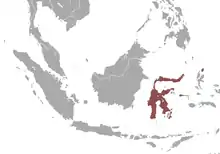| Swift fruit bat | |
|---|---|
| Scientific classification | |
| Domain: | Eukaryota |
| Kingdom: | Animalia |
| Phylum: | Chordata |
| Class: | Mammalia |
| Order: | Chiroptera |
| Family: | Pteropodidae |
| Genus: | Thoopterus |
| Species: | T. nigrescens |
| Binomial name | |
| Thoopterus nigrescens (Gray, 1870) | |
 | |
| Swift fruit bat range | |
| Synonyms | |
| |
The swift fruit bat (Thoopterus nigrescens) is a species of megabat in the family Pteropodidae.[2]
Taxonomy
The swift fruit bat was initially described in 1870 by British zoologist John Edward Gray.[3] He placed it in the genus Cynopterus, with a name of Cynopterus marginatus var. nigrescens. The type specimen had been collected on the Indonesian island of Morotai by Alfred Russel Wallace.[4]
In 1899, German zoologist Paul Matschie created the subgenus Thoopterus within Cynopterus, into which he placed Cynopterus nigrescens.[5][3] By 1912, Danish mammalogist Knud Andersen classified Thoopterus as a full genus, with T. nigrescens as the type species.[6]
Description
The combined length of the head and body is 94–109 mm (3.7–4.3 in), with a forearm length of 70–82 mm (2.8–3.2 in). Individuals weigh about 67–99 g (2.4–3.5 oz). The fur is grayish-brown.[7]
Range and habitat
The swift fruit bat is endemic to Indonesia, where it is found on the following islands: Sulawesi, Buton, Mangole, Wawonii, the Talaud and Sangihe archipelagos, and likely Morotai. It is found at elevations between 0–2,400 m (0–7,874 ft) above sea level. It seems to prefer intact forests, though will also utilize disturbed forests.[1]
References
- 1 2 Wiantoro, S.; Tsang, S.M.; Ruedas, L.A.; Kingston, T.; Helgen, K.; Sinaga, J. (2020). "Thoopterus nigrescens". IUCN Red List of Threatened Species. 2020: e.T21815A21989441. doi:10.2305/IUCN.UK.2020-2.RLTS.T21815A21989441.en. Retrieved 14 November 2021.
- ↑ Ruedas 2008; Simmons 2005.
- 1 2 Hollister, Ned (1911). A review of the Philippine land mammals in the United States National Museum. U.S. Government Printing Office. pp. 188–190.
- ↑ Gray, J. E. (1870). Catalogue of monkeys, lemurs, and fruit-eating bats in the collection of the British Museum. Order of the Trustees. p. 123.
- ↑ Matschie, P. (1899). Die Fledermäuse des Berliner Museums für Naturkunde. 1. Lieferung. Die Megachiroptera des Berliner Museums für Naturkunde. Museum für Naturkunde in Berlin. p. 77.
- ↑ Andersen, K. (1912). "Catalogue of the Chiroptera In the collection of the British Museum. Volume I: Megachiroptera". Catalogue of the Chiroptera in the Collection of the British Museum. London: BMNH. 1: 662–665.
- ↑ Nowak, R. M.; Pillsbury Walker, E. (1999). Walker's Mammals of the World. Vol. 1. JHU Press. p. 290. ISBN 9780801857898.
